



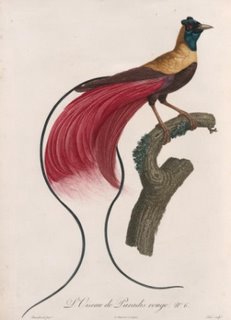


Histoire Naturelle des Oiseaux de Paradis at NYPL. Published 1806 by Francois Levaillant. Jacques Barraband, artist. (115 colour plate thumbnails over 10 web pages)
Levaillant was a notable ornithologist originally from Surinam but educated in France, who went on a couple of exploratory tours of Africa. He released 2 sets of popular volumes recounting his travels and documenting the birds of Africa and later wrote a number of other ornithological works. Because of his opposition to Linnaeus's binomial nomenclature system, species were only given popular french names (in the image URLs above). Barraband is considered to be the leading French ornithological artist of the 18th century.
Saturday, November 26, 2005
Les Oiseaux de Paradis
Microcosmos









Belgian cartographic printer and engraver Gèrard de Jode (1509-1591) produced the emblem book Microcosmos: Parvus Mundus in 1579 and it was published in latin. It appears that the symbolic illustrations and accompanying text outline moral truths by the combination of biblical quotes/scenarios with aspects of the lives of the ancients such as Plato and Socrates and mythical personas like Hercules. That's my take anyway. The original illustrations are those toward the bottom here.
I came to this fascinating collection of emblems by way of an Illinois University database which hosts a 1670 'copy' of Microcosmos. I liked the engravings and as I started to search for some more information about the stated author, Martin Meyer, I came across the original version at the University of Mannheim.
I put 'copy' in quotes for 2 reasons. Firstly, the later version has been expanded as far as I can tell and those emblems that have similarities (sometimes very very similar) are in actual fact reversed, as you see above with the repeated 'Sphinx' from each book. Both sites have digitized images and they each appear to have the indicative markings of engraving plates so I'm not sure how the mirror effect has been transposed. Somewhere along the line in the copying process no doubt. Anyway, I thought I'd post a few from each as they both have their own merits. The later version has both latin and german text accompanying the emblems. [The image URLs give a hint as to the emblem title - sorry, I got sidetracked etc etc]
- University of Mannheim Microcosmos - Gèrard de Jode 1579. [translation]
- University of Illinois Microcosmos - Martin Meyer 1670.
- And of course the always observant misteraitch has plowed this field previously I now see.
- A very short biography of de Jode.
- The cartographic perspective.
Friday, November 25, 2005
Two Dutch Dolls and a ... Controversy

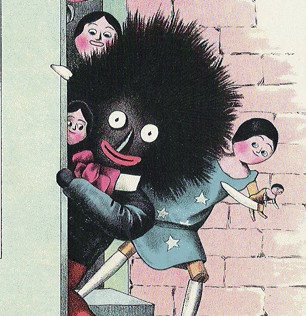
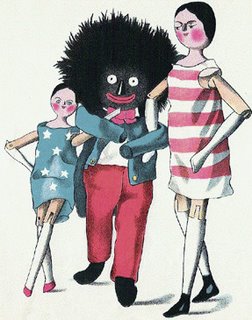

Florence K Upton lived in USA until she was 14 years old when she settled in England with her family. As a child she had a minstrel doll and she ".. knew he was ugly!". The doll was treated roughly by the Upton children. Yet it was to be her inspiration when in 1895 she produced a series of illustrations to accompany a poem-story her mother, Bertha Upton, had written.
"Two Dutch Dolls and a Golliwogg" was the first of 12 books the Uptons would publish. They were immediately popular in England and Europe and the name (eventually shortened to 'golliwog') became an iconic figure, with the release of golliwog dolls and brand logos and other books adopting the character.
The whole of the text and all the book images of Two Dutch Dolls and a Golliwogg are online at the Gutenburg project. I read it all and looked closely at the pictures and I'm inclined to view the book and the illustrations as a whole in an innocent light. It's a pinocchioesque story where caricatures are the norm and it tends towards inclusivity of differences rather than as any vehicle for propagating a racist mentality in my opinion. One could take a perverse view and see other tropes of racism and stereotyping excluding any alleged (intentional or otherwise) slurring against dark skinned people.
But I won't go into any full blown exegesis - I simply like the illustrations - however, I acknowledge that the character and the name have been manipulated and established in many arenas as racist icons. I imagine that feeling is much stronger in the States. There seems to be a stalemate of sorts as to the rightful place deserved for the golliwog character. Because it is an image, there is possibly a stronger evocation of a negative assessment versus, for instance, archaic use of the n-word in literature.
But I don't see any contradiction in having an innocent appreciation for the appearance in history of the golliwog character whilst at the same time detesting the development of the emblem with racist themes.
- Jim Crow Museum of Racist Memorabilia at Ferris University.
- A few larger Two Dutch Dolls illustrations with a front cover sans 'Golliwogg' in the title.
- Golliwogsdotcom have a bunch of book illustrations and fan ephemera - obviously representing one pole on the spectrum of opinion.
- A few illustrations from Golliwogg's Bicycle Tour.
- Golliwogg in wikipedia.
- A great metafilter post on minstrels.
[via]
Thursday, November 24, 2005
Illuminated Failing Love






BNF Richelieu Manuscrits Français 143
Évrard de Conty, Échecs amoureux, France, Cognac, XVe siècle, Robinet Testard
Jacobus Magni, Archiloge sophie at the Bibliothèque Nationale de France Gallica website. "Failures in Love"
The skerricks of information about this late 15th century parchment I've found indicate that the original text by Évrard de Conty, doctor to King Charles V, was copied and illuminated by Robinet Testard for Louise of Savoy. It is a work of moral allegory inspired largely by le Roman de la Rose. [thanks spyda man]
Chief Celebratory Portraits
"He has painted the Indian lineaments on the spot, and is entitled to patronage — not as supplying all that is desirable, or practicable, perhaps, but as a first and original effort. We should cherish all such work."
HR Schoolcraft
James Otto Lewis attended treaty council meetings in the Great Lakes region between 1825 and 1827 on a commission from the Indian Department. His portraits were to be distributed as hand coloured lithographs to subscribers in 10 installments with a subsequent circular recording his interviews of the native American Chiefs that sat for him.
It is unknown whether his recollections were ever published. The venture hurt Lewis financially and the last few installments were issued in reduced numbers. The engraving and hand colouring was carried out by Lehman & Duval lithographers of Philadelphia in 1836. This series of 80 portraits is held in high regard, judging from my reading around, in so far as they were the first organized portraits of a large number of Chiefs. The original paintings were destroyed in a fire at the Smithsonian Institution in 1865.
A rare complete set of the lithographs from The Aboriginal Port Folio or a Collection of Portraits of the Most Celebrated Chiefs of the North American Indians is hosted by the Indiana Historical Society (and no doubt other institutions).
[Is it Thanksgiving yet? Should it be capitalized? Is it one word? I suppose I could search that for myself.]
I see a quiet dignity in the faces of the portrait subjects. Previous North American Indian lithographs.
Wednesday, November 23, 2005
Animalium Quadrupedum
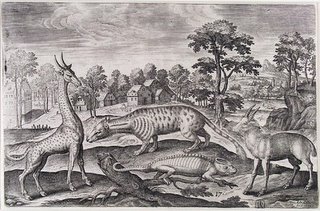

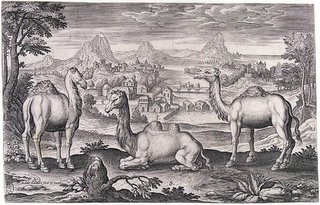


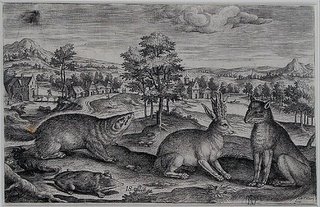
The Animalium Quadrupedum series of engravings by Adriaen Collaert is hosted by the wonderful Memory of the Netherlands site of which this page of about 15 images forms part of the 16th Century Graphic Art from the Northern and Southern Netherlands section.
Flemish draughtsman, engraver and publisher Adriaen Collaert (1560-1618) was thought to have been trained in his engraving techniques by his father-in-law, Philip Galle. Collaert engraved a few nature series such as Animalium Quadrupedum, which were based on his own drawings but the majority of his engraving legacy is devoted to reproductions. Artcyclopedia.
The Tulip Book



The Tulip Book of P.Cos in the Special Collections of Wageningen UR Library. The handpainted book was made in 1637 during the tulipomania that swept Holland. The third image above was worth the equivalent of $US 2-3 million at today's rates!
Elementary Exercises In Youthful Intuition



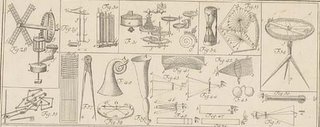


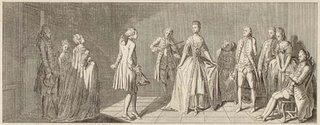


Elementarwerke für die Jugend und ihre Freunde = Recuel D'Estampes relatives au Manuel Elémentaire D'Education Par Jean Bernard Basedow destinées A L'Usage Des Jeunes Gens Et De Leurs Amis = Tabularum Aenarum Collectio Ad Joannis Bernhardi Basedovii Opus Elementare In Usum Juventutis Et Illius Amicorum. (search result thumbnail page)
Approximately: "Elementary Work for Youth and their Friends"
Published in 1774 by JB Basedow with about 100 very detailed copper engravings by Daniel Chodowiecki.
From some rummaging around and very suspect translations I can tell you that Basedow founded an 'alternative' school in Dessau. His reforming beliefs came from a need to change from an hitherto agrarian outlook in society to education of young people to take up positions in newly emerging factories (I am paraphrasing).
"The elementary work treats humans, the logic, the religion and sittenlehre, the occupations and conditions of humans, finally history and natural history in nine books basic questions of the education, then. With the connection of text and picture, factual information and its dia.-logical discussion Basedow created the modern type of the Realienbuchs."
This funkily incongruous set of images comes from a german (historical - all out of copyright) illustration database called Pictura Paedagogica Online (translation).
You can't ask me how I found the above book because I really have no idea (nor any german knowledge whatsoever). But there is some intuitiveness about the website arrangement that may lead you on to finding some remarkable book illustrations, postcards and other images. It is a unique (to me) type of database and I will give them the BibliOdyssey award of the week for contributions to digital aesthetics, despite them having been online for 5 years.






































































